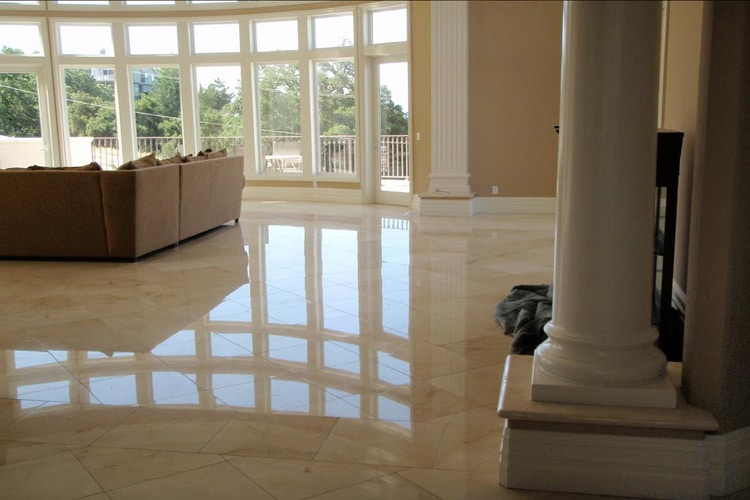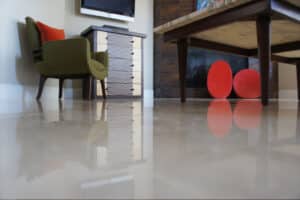Marble surfaces have long been admired for their timeless beauty and elegant appearance. Whether in a grand foyer, a luxurious bathroom, or a gourmet kitchen, marble adds a touch of opulence to any space. However, when it comes to maintaining the pristine look of marble, there are two primary finishing options to consider: honed and polished. In this blog, we’ll explore the differences in appearance, the processes of honing and polishing, and the maintenance required to keep both finishes looking their best.
The Look: Honed vs. Polished
Before diving into maintenance, let’s first understand the visual distinctions between honed and polished marble surfaces.
Honed Marble: Honed marble has a matte or satin finish that offers a softer and more understated appearance compared to polished marble. When you run your hand over honed marble, it feels smooth but lacks the high-gloss sheen associated with polished marble. This finish enhances the natural color and veining of the stone while reducing the glare and reflections often seen on polished surfaces. Honed marble exudes a subtle elegance and a tactile appeal that many homeowners find appealing.
Polished Marble: Polished marble, on the other hand, boasts a glossy, mirror-like finish that is both luxurious and striking. The surface is smooth to the touch, and it reflects light beautifully, creating a bright and airy ambiance in any space. Polished marble intensifies the depth of color and enhances the stone’s natural patterns, creating a vibrant and glamorous look. Its lustrous appearance is a classic choice for upscale interiors.
The Process: Honing and Polishing
The difference in appearance between honed and polished marble surfaces is primarily achieved through distinct finishing processes.
Honing: Honing is the process of grinding the marble surface with abrasives to remove a thin layer of the stone, revealing a matte finish. This process also eliminates any imperfections, such as scratches or etches, resulting in a smooth and uniform surface. Honed marble maintains the stone’s natural color and veining while offering a tactile and refined appearance.
Polishing: Polishing involves using progressively finer abrasive materials to create a smooth, glossy finish on the marble surface. The process brings out the full depth of color and highlights the intricate veining of the stone. Polished marble is achieved through meticulous grinding and buffing, resulting in a highly reflective and stunning surface.
Maintenance: Honed vs. Polished Marble
Now that we’ve covered the aesthetic differences, let’s delve into the maintenance requirements for both honed and polished marble surfaces.
Honed Marble Maintenance
Sealing: Honed marble is more porous than polished marble, making it susceptible to staining. To protect it, apply a high-quality marble sealer. Depending on usage, resealing may be needed every 1-3 years.
Regular Cleaning: Clean honed marble surfaces with a pH-neutral stone cleaner. Avoid acidic or abrasive cleaners, as they can damage the finish. Wipe up spills promptly to prevent staining.
Avoid Scratches: While honed marble is less prone to visible scratches, it can still be scratched by abrasive materials. Use coasters, placemats, and felt pads under furniture to prevent scratches and etches.
Maintenance Polishing: Over time, the honed finish may develop a patina due to wear. You can restore its luster with periodic honing and polishing by a professional stone restoration service.
Polished Marble Maintenance
Sealing: Like honed marble, polished marble should also be sealed to prevent staining. Seal the surface initially, and then reseal as needed, typically every 1-2 years.
Regular Cleaning: Clean polished marble with a pH-neutral stone cleaner and a soft, damp cloth. Avoid harsh chemicals or abrasive materials, as they can dull the shine.
Avoid Acidic Substances: Polished marble is more susceptible to etching from acidic substances like vinegar, citrus juices, and wine. Wipe up spills immediately, and use coasters and trivets to protect the surface.
Buffing: To maintain the high-gloss finish of polished marble, regular buffing by a professional stone restoration service may be necessary. This process helps to remove small scratches and restore the shine.
Preventative Measures: Place rugs or mats in high-traffic areas to reduce wear on the polished surface. Consider using furniture pads to prevent scratches and dents.
Both honed and polished marble surfaces offer distinct aesthetic qualities, with honed marble exuding a softer, matte elegance, and polished marble showcasing a glossy, opulent look. When it comes to maintenance, both finishes require sealing, regular cleaning, and protective measures. However, polished marble demands more attention to prevent etching and maintain its high-gloss appearance. Ultimately, the choice between honed and polished marble depends on your aesthetic preferences and your willingness to invest in maintenance to preserve the beauty of your marble surfaces. Whichever finish you choose, proper care will ensure that your marble surfaces continue to grace your home with their timeless allure for years to come.
Natural Stone Cleaning in Houston TX
The realm of natural stone care finds its epitome in Modern Stone Care, where our highly knowledgeable technicians specialize in the meticulous restoration, cleaning, polishing, and sealing of all-natural stone surfaces. This comprehensive domain spans diverse areas, including but not limited to flooring, countertops, and even outdoor pool coping. Our unwavering commitment revolves around the preservation of your natural stone’s allure, ensuring it continues to exude the resplendence of its origins. Entrust the delicate art of natural stone care to the adept professionals at Modern Stone Care, who stand poised to offer the pinnacle of stone care services in Houston and its surrounding areas.
Modern Stone Care
970 Bunker Hill Rd
Houston, TX 77024
(832) 814–2041
View our Google Business Listing
View our Facebook Page







